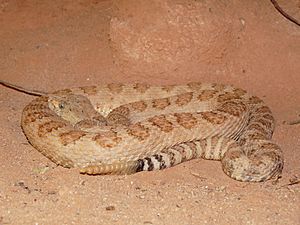Crotalus oreganus abyssus facts for kids
Quick facts for kids Crotalus oreganus abyssus |
|
|---|---|
 |
|
| Grand Canyon rattlesnake Havasu Canyon, Arizona |
|
| Scientific classification |
|
| Kingdom: | Animalia |
| Phylum: | Chordata |
| Class: | Reptilia |
| Order: | Squamata |
| Suborder: | Serpentes |
| Family: | Viperidae |
| Genus: | Crotalus |
| Species: | |
| Subspecies: |
C. o. abyssus
|
| Trinomial name | |
| Crotalus oreganus abyssus Klauber, 1930
|
|
| Synonyms | |
|
|
The Grand Canyon rattlesnake, also called the canyon bleached rattlesnake, is a special kind of venomous snake. It's a type of pit viper, which means it has special heat-sensing pits on its face to help it find prey. You can only find this snake in certain parts of the U.S. states of Arizona and Utah, especially around the amazing Grand Canyon.
Contents
What Does the Grand Canyon Rattlesnake Look Like?
This rattlesnake is usually a medium to large size. Adult snakes can be anywhere from 16 to 54 inches (about 41 to 137 centimeters) long. That's roughly the length of a baseball bat!
Colors and Patterns
These snakes have cool patterns on their backs. They often have dark blotches, which are like big spots. These blotches appear on many different background colors. You might see snakes that are reddish, pink, yellow-green, light tan, or gray.
Near their tail, the blotches often change into stripes that go across their body. Young snakes usually have clearer blotches and markings on their faces. Some adult snakes might not have any body markings at all.
Unique Facial Scales
If you look closely at their face, the scale right at the tip of their nose, called the rostral scale, usually touches more than two scales behind it. These are called internasal scales.
Where Do Grand Canyon Rattlesnakes Live?
You can find these snakes in northwestern and north-central Arizona. They live along both the top edges (rims) and the bottom (floor) of the Grand Canyon. They also live in areas next to the Grand Canyon.
Living in Utah
Their home range also extends north into Utah. In Utah, they are found on the Kaiparowits Plateau. This area is located between the Escalante River and Paria River Drainages, in Kane and Garfield Counties.
What Kind of Places Do They Call Home?
The Grand Canyon rattlesnake can live in many different types of environments. They are very adaptable!
Different Habitats
- Grasslands: Areas covered mostly by grass.
- Desert Scrubland: Dry areas with small bushes and plants, like the Great Basin Desert.
- Canyon Bottoms: The lower parts of the Grand Canyon.
- Rocky Slopes: Areas with loose rocks (talus) and steep cliffs.
- Rolling Hills: Gently sloped hills and flat areas at the base of mountains (bajadas) in forests with pine and juniper trees.
- Pine Forests: Areas with lots of pine trees.
How Do Grand Canyon Rattlesnakes Behave?
These snakes are mostly active during the day. This means they are diurnal. However, if the weather is just right, they might be active at any time of day or night.
Blending In
They have a special ability to blend in with their surroundings. This is called cryptic coloration. Their colors and patterns help them hide perfectly among the rocks and dirt. They also tend to be very calm. Because of their good camouflage and calm nature, people often walk right by them without even noticing they are there!
What Do Grand Canyon Rattlesnakes Eat?
The Grand Canyon rattlesnake is a predator. It hunts and eats smaller animals to survive.
Their Diet
Their favorite foods include:
- Squirrels
- Mice
- Lizards
- Birds

